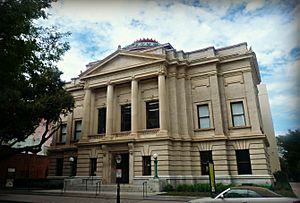Gibbes Museum of Art facts for kids

The Gibbes Museum of Art
|
|
| Established | 1905 |
|---|---|
| Location | 135 Meeting Street Charleston, South Carolina |
| Type | Art museum |
The Gibbes Museum of Art is a cool art museum located in Charleston, South Carolina. It used to be called the Gibbes Art Gallery. The museum started as the Carolina Art Association way back in 1858. In 1905, it moved into its beautiful new building, designed in the Beaux Arts style, at 135 Meeting Street. This building is in the historic part of Charleston. The Gibbes Museum has an amazing collection of over 10,000 pieces of fine art. Most of these artworks are American, and many have a special connection to Charleston or the Southern United States.
Contents
How the Museum Started
The Gibbes Museum of Art exists thanks to a generous person named James Shoolbred Gibbes. He donated $100,000 to the Carolina Arts Association. This money was meant to build a proper place to show paintings. The city received the money in 1903 after a legal case about Gibbes' will was settled.
Designing the Building
After getting the donation, the Association hired Frank Pierce Milburn to design the art gallery. He planned a beautiful building with a special dome, tall columns, and fancy windows. Milburn finished the drawings in mid-1903. A picture of the planned building was even shown in the Charleston Evening Post newspaper on June 5, 1903.
Building the Museum
In September 1903, H.T. Zacharias was chosen as the builder. He received a contract for $73,370 to construct the building. Work began on September 28, 1903. They first had to clear the old South Carolina Agricultural Hall that was on the land. Even though they had already started the foundations, a special ceremony was held on December 8, 1903. This was to lay the first stone of the building.
The museum officially opened its doors on April 11, 1905. On opening day, visitors could see more than 300 paintings. There were also many bronze statues and about 200 tiny miniature artworks. Plus, there was a cool collection of Japanese prints.
Modern Renovations
The museum closed for two years in the early 2000s for a big renovation. This project cost $13.5 million. The museum reopened to the public on May 28, 2016. During the renovation, the teams found the original blueprints of the building from 1905. They used these plans to make the museum look like it did when it first opened.
The first floor of the museum now has classrooms and art studios. There are also spaces for lectures and events, plus a museum shop. A reception area at the back opens up to a lovely garden. This garden is part of Charleston's historic Gateway Walk. The best part is that the entire ground floor of the museum is free to enter!
Art Collections
The Gibbes Museum has many artworks by artists who lived in or had connections to Charleston. Some of these artists include Charles Fraser, William Melton Halsey, Ned I.R. Jennings, Henrietta Johnston, Mary Roberts, Merton Simpson, and Jeremiah Theus. The museum also has a collection of photographs by George LaGrange Cook. These include pictures taken after the big 1886 Charleston earthquake.



